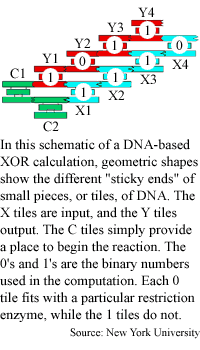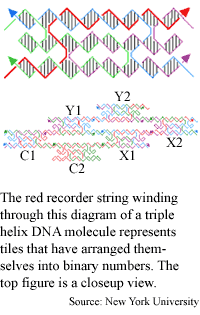
DNA does logic
By Kimberly Patch, Technology Research NewsA group of researchers have coaxed bits of DNA to assemble themselves in a way that resulted in a logic operation.
The feat is useful for two different types of research. First, it is an important step toward using DNA to perform a vast number of computations at once. Second, this type of self-assembly could be used to build nanoscale devices.
The researchers used tiles, or short pieces of DNA, that had several distinct traits. They all had "sticky ends," meaning their ends would attach only to a corresponding end on another piece of DNA, like a lock and key. (See Figure 1) Two types of tiles represented the ones and zeros of binary logic. Each 0 tile had a site that fit with a particular restriction enzyme, while the 1 tiles did not have that site. The tiles were also divided into input, or X tiles and output, or Y tiles.
The researchers mixed the tiles in a test tube and they assembled themselves into a string of DNA in a certain order because each piece only fit with two other distinct pieces, like a puzzle. Four X tiles formed a four-digit binary number and four Y tiles formed a corresponding number. The assembly represented an XOR logic calculation. In an XOR calculation, the result is true, or 1, if the values compared are the same, and false, or 0, if they differ.
In essence, the researchers made an XOR circuit out of DNA. "We've proven we can do logic by self-assembly of DNA," said Nadrian Seeman, a chemistry professor at New York University.
This result was also a multistep logical process in a single step. The tiles self-associated themselves to form this arrangement," said Seeman. Usually when researchers manipulate DNA, reactions are done in single step processes with researchers doing something like adding a new enzyme for each step.
To see the order of the tiles in the DNA, the researchers had to isolate the single strand that contained the 1 and 0 tiles. This recorder string wandered through the triple helixes of the DNA molecule. (See Figure 2)
The researchers extracted that strand by breaking down the weak hydrogen bonds that held the bulk of the DNA together, leaving the stronger covalent bonds that held together the tiles with the sticky ends. The researchers then determined the order of the ones and zeros by mixing the strand with the enzyme that reacts with the zero tiles.
The work goes beyond a simple molecular reaction to produce a true algorithm because it allows for "conditional information flow in a sequence of molecular interactions" said Erik Winfree, an assistant professor of computer science and computation and neural systems at Caltech. "By studying algorithmic self-assembly, [the researchers] are exploring our ability to program molecular interactions, in the true sense of the word," said Winfree.
In the end, this type of algorithmic self-assembly "is computation, whether the output is numerical or a nano-fabricated device," said Winfree.
The researchers used a type of DNA that, in contrast to the double helix of biological DNA that is made up of two single strands, uses four single strands that repeatedly cross over each other to make up three double helixes. This makes for a less floppy molecule.
Using stiff DNA is important both for doing increasingly complicated calculations and for using DNA as scaffolding for nanoscale building, said Seeman. "You need stiff components not so much to get them to stay together... but to maintain their structural integrity. If you glue [marshmallows] with epoxy they'll be tough as hell in terms of the bond, but how big a house can you build out of marshmallows?"
The researchers are planning to build more complicated DNA molecules for two distinct uses, said Seeman. The XOR calculation was a very simple molecule, he said.
Enabled by the stiff DNA technology, self-assembled molecules of DNA can be expanded beyond a simple line of molecules into two or three dimensions, both to enable more complicated calculations and to form far more complex patterns, said Seeman."When I talk about patterns I'm talking about building circuits... using DNA molecules as scaffolding to direct other materials [like] nano electronic components, quantum dots, wires, switches," said Seeman. "We expect to make fairly complex patterns with relatively simple sets of input," he added.
Because many DNA strands can be created in parallel, all the possible answers to a certain arrangement can be found at once and many patterns can be created at once. For instance, the inputs and outputs of the researcher's XOR calculation were four-digit binary numbers, which yield 16 possible combinations that can be found all at once in a test tube. As calculations get vastly more complicated, massively parallel computations that easily outstrip today's conventional computers are possible. "We don't have one molecule in our pot here, we have 10 to the 12th," said Seeman. The massively parallel nature of DNA makes it potentially cheap for both calculation and building, Seeman said.
Both practical DNA computers and processes that use DNA to assemble nanoscale devices are a decade away, he said.
Seeman's colleagues were Chengde Mao of New York University and Thomas H. Lebean and John H. Reif of Duke University. The research was funded by the National Institute of Health (NIH) the Office of Naval Research (ONR) the National Science Foundation (NSF), the U.S. Air Force and DARPA.
Timeline: 10 years
Funding: Government
TRN Categories: Biological, Chemical, DNA and Molecular Computing
Story Type: News
Related Elements: Diagram; Technical paper, "Logical Computation Using Algorithmic Self-assembly of DNA Triple Crossover Molecules," Nature, September 28, 2000
Advertisements:
October 4, 2000
Page One
DNA does logic
Quantum quirk promises smaller circuits
Pop-up book melds real with virtual
Lab-on-a-CD corrects itself
Linked particles advance quantum computing


News:
Research News Roundup
Research Watch blog
Features:
View from the High Ground Q&A
How It Works
RSS Feeds:
News
Ad links:
Buy an ad link
| Advertisements:
|
 |
Ad links: Clear History
Buy an ad link
|
TRN
Newswire and Headline Feeds for Web sites
|
© Copyright Technology Research News, LLC 2000-2006. All rights reserved.